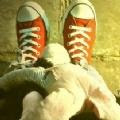Emoticon that was the right term.
Some background information about emoticon, An emoticon is a textual expression representing the face of a writer's mood or facial expression. Emoticons are often used to alert a responder to the tenor or temper of a statement, and can change and improve interpretation of plain text. The word is a portmanteau of the English words emotion (or emote) and icon. In web forums, instant messengers and online games, text emoticons are often automatically replaced with small corresponding images, which came to be called emoticons as well.
The use of emoticons can be traced back to the nineteenth century and were commonly used in casual and/or humorous writing.[citation needed]Internet were included in a proposal by Scott Fahlman in a message on 19 September 1982.[1]
Emoticons published in the March 30, 1881 issue of Puck.
The National Telegraphic Review and Operators Guide in April 1857 documented the use of the number 73 in Morse code to express "love and kisses" (later reduced to the more formal "best regards"). Dodge's Manual in 1908 documented the reintroduction of "love and kisses" as the number 88. Gajadhar and Green comment that both Morse code abbreviations are more succinct than modern abbreviations such as LOL.[2][3]
A New York Times transcript from Abraham Lincoln's speech written in 1862 discovered by Bryan Benilous appears to contain a "winking" emoticon, but it is unclear whether it is an actual use, a typo[4] or a legitimate punctuation construct.
Typographical emoticons were published in 1881 by the U.S. satirical magazine Puck. In 1912 Ambrose Bierce proposed "an improvement in punctuation — the snigger point, or note of cachinnation: it is written thus \___/! and presents a smiling mouth. It is to be appended, with the full stop [or exclamation mark as Bierce's later example used], to every jocular or ironical sentence".[5]
Emoticons had already come into use in sci-fi fandom in the 1940s,[6] although there seems to have been a lapse in cultural continuity between the communities. In 1963 the "smiley face", a yellow button with two black dots representing eyes and an upturned thick curve representing a mouth, was created by freelance artist Harvey Ball. It was realized on order of a large insurance company as part of a campaign to bolster the morale of its employees and soon became a big hit. This smiley presumably inspired many later emoticons; the most basic graphic emoticon that depicts this is in fact a small yellow smiley face.
In a New York Times interview in April 1969, Alden Whitman asked writer Vladimir Nabokov: "How do you rank yourself among writers (living) and of the immediate past?" Nabokov answered: "I often think there should exist a special typographical sign for a smile — some sort of concave mark, a supine round bracket, which I would now like to trace in reply to your question."
http://en.wikipedia.org/wiki/Emoticon
Creation of :-) and :-(
The first person documented to have used the emoticons :-) and :-(, with a specific suggestion that they be used to express emotion, was Scott Fahlman;[10] the text of his original proposal, posted to the Carnegie Mellon University computer science general board on 19 September 1982 (11:44), was thought to have been lost, but was recovered twenty years later by Jeff Baird from old backup tapes.[1]

1 comment:
you must cite the writing of others as these are not your words.
Post a Comment